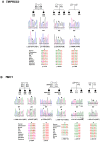Non-syndromic hearing impairment in India: high allelic heterogeneity among mutations in TMPRSS3, TMC1, USHIC, CDH23 and TMIE
- PMID: 24416283
- PMCID: PMC3885616
- DOI: 10.1371/journal.pone.0084773
Non-syndromic hearing impairment in India: high allelic heterogeneity among mutations in TMPRSS3, TMC1, USHIC, CDH23 and TMIE
Abstract
Mutations in the autosomal genes TMPRSS3, TMC1, USHIC, CDH23 and TMIE are known to cause hereditary hearing loss. To study the contribution of these genes to autosomal recessive, non-syndromic hearing loss (ARNSHL) in India, we examined 374 families with the disorder to identify potential mutations. We found four mutations in TMPRSS3, eight in TMC1, ten in USHIC, eight in CDH23 and three in TMIE. Of the 33 potentially pathogenic variants identified in these genes, 23 were new and the remaining have been previously reported. Collectively, mutations in these five genes contribute to about one-tenth of ARNSHL among the families examined. New mutations detected in this study extend the allelic heterogeneity of the genes and provide several additional variants for structure-function correlation studies. These findings have implications for early DNA-based detection of deafness and genetic counseling of affected families in the Indian subcontinent.
Conflict of interest statement
Figures



Similar articles
-
Genetic spectrum of autosomal recessive non-syndromic hearing loss in Pakistani families.PLoS One. 2014 Jun 20;9(6):e100146. doi: 10.1371/journal.pone.0100146. eCollection 2014. PLoS One. 2014. PMID: 24949729 Free PMC article.
-
Identification of a novel homozygous mutation, TMPRSS3: c.535G>A, in a Tibetan family with autosomal recessive non-syndromic hearing loss.PLoS One. 2014 Dec 4;9(12):e114136. doi: 10.1371/journal.pone.0114136. eCollection 2014. PLoS One. 2014. PMID: 25474651 Free PMC article.
-
Spectrum and frequencies of non GJB2 gene mutations in Czech patients with early non-syndromic hearing loss detected by gene panel NGS and whole-exome sequencing.Clin Genet. 2020 Dec;98(6):548-554. doi: 10.1111/cge.13839. Epub 2020 Sep 27. Clin Genet. 2020. PMID: 32860223
-
Global Distribution of Founder Variants Associated with Non-Syndromic Hearing Impairment.Genes (Basel). 2023 Feb 3;14(2):399. doi: 10.3390/genes14020399. Genes (Basel). 2023. PMID: 36833326 Free PMC article. Review.
-
Autosomal recessive non-syndromic hearing loss genes in Pakistan during the previous three decades.J Cell Mol Med. 2024 Apr;28(8):e18119. doi: 10.1111/jcmm.18119. J Cell Mol Med. 2024. PMID: 38534090 Free PMC article. Review.
Cited by
-
Identification of novel CDH23 variants linked to hearing loss in a Chinese family: A case report.Medicine (Baltimore). 2024 Sep 13;103(37):e39360. doi: 10.1097/MD.0000000000039360. Medicine (Baltimore). 2024. PMID: 39287240 Free PMC article.
-
Distinct functions of TMC channels: a comparative overview.Cell Mol Life Sci. 2019 Nov;76(21):4221-4232. doi: 10.1007/s00018-019-03214-1. Epub 2019 Oct 4. Cell Mol Life Sci. 2019. PMID: 31584127 Free PMC article. Review.
-
The p.P240L variant of CDH23 and the risk of nonsyndromic hearing loss: a meta-analysis.Eur Arch Otorhinolaryngol. 2019 Jan;276(1):11-16. doi: 10.1007/s00405-018-5160-8. Epub 2018 Oct 26. Eur Arch Otorhinolaryngol. 2019. PMID: 30367262 Review.
-
Identification of a novel homozygous mutation in transmembrane channel like 1 (TMC1) gene, one of the second-tier hearing loss genes after GJB2 in India.Indian J Med Res. 2017 Apr;145(4):492-497. doi: 10.4103/ijmr.IJMR_397_15. Indian J Med Res. 2017. PMID: 28862181 Free PMC article.
-
Genetics Landscape of Nonsyndromic Hearing Loss in Indian Populations.J Pediatr Genet. 2021 Dec 14;11(1):5-14. doi: 10.1055/s-0041-1740532. eCollection 2022 Mar. J Pediatr Genet. 2021. PMID: 35186384 Free PMC article. Review.
References
-
- Morton NE (1991) Genetic epidemiology of hearing impairment. Ann N Y Acad Sci 630: 16–31. - PubMed
-
- Yan D, Liu XZ (2008) Cochlear molecules and hereditary deafness. Front Biosci 13: 4972–4983. - PubMed
-
- Scott HS, Kudoh J, Wattenhofer M, Shibuya K, Berry A, et al. (2001) Insertion of beta-satellite repeats identifies a transmembrane protease causing both congenital and childhood onset autosomal recessive deafness. Nat Genet 27: 59–63. - PubMed
-
- Kurima K, Peters LM, Yang Y, Riazuddin S, Ahmed ZM, et al. (2002) Dominant and recessive deafness caused by mutations of a novel gene, TMC1, required for cochlear hair-cell function. Nat Genet 30: 277–284. - PubMed
-
- Verpy E, Leibovici M, Zwaenepoel I, Liu XZ, Gal A, et al. (2000) A defect in harmonin, a PDZ domain-containing protein expressed in the inner ear sensory hair cells, underlies Usher syndrome type 1C. Nat Genet 26: 51–55. - PubMed
Publication types
MeSH terms
Substances
LinkOut - more resources
Full Text Sources
Other Literature Sources
Molecular Biology Databases

